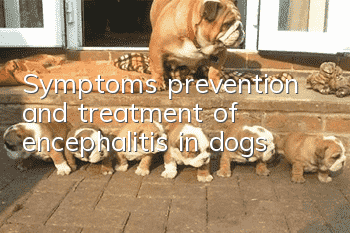Symptoms, prevention and treatment of encephalitis in dogs

Encephalitis refers to inflammation of the meninges and brain parenchyma caused by infection or toxic factors. In a broad sense, encephalitis includes various brain infections and encephalopathy. The cause of purulent encephalitis is mostly caused by purulent bacteria, head trauma, purulent lesions in nearby areas, systemic sepsis, and blood transfer. Parasitic encephalitis can also be caused by the migration of larvae of certain parasites into the brain tissue. Non-suppurative encephalitis is more common secondary to infectious diseases, such as canine distemper and rabies. Bacterial diseases can also cause encephalitis. So what are the main symptoms and treatments of encephalitis?
Chinese Crested Dog
Symptoms of encephalitis in dogs
1. Symptoms of systemic toxin
Fever, headache, body aches, nausea, vomiting, fatigue. A few have hemorrhagic rash and myocarditis.
2. Nervous system symptoms
Disorder of consciousness, meningeal irritation sign. Flaccid paralysis of the neck muscles and scapular muscles may occur, resulting in drooping of the head and inability to lift the arms, causing the patient to be shaken and helpless. Involvement of cranial nerves and lower limbs is rare. Paralysis can be recovered in about 2 to 3 weeks, and about half of the muscles atrophy. Mild cases may have no obvious neurological symptoms.
Professional mild cases may only have headache, dizziness, neck stiffness, etc., which are symptoms of serous meningitis. When the disease is severe and diffuse, consciousness disorder, delirium and agitation, cranial nerve palsy, limb paralysis, involuntary movements, and urination may occur. Disorders, convulsions and other symptoms. When the disease progresses further, the patient can fall into a deep coma and be in a decerebrate or decortical state. Sometimes the lesions can be limited to the brainstem, spinal cord and other parts of the body, causing corresponding symptoms called brainstemitis or myelitis respectively. When inflammation develops to the deep part of the brain or there are inflammatory lesions in the deep part of the brain, it can cause general paralysis or incomplete paralysis, limb movement disorders, drooping eyelids, mydriasis, and paralysis of the optic nerve, masseter muscles, pharyngeal muscles, larynx, and tongue. Lying on the ground motionless, external reactions completely lost.
Most German shepherds suffering from encephalitis have elevated body temperatures and lose their appetite in the later stages.
Treatment of encephalitis in dogs
1. Eliminate inflammation, calm down, reduce intracranial pressure, and prevent cerebral edema.
(1) Inject 50 mg/kg body weight of sodium sulfadiazine intravenously, twice a day.
Penicillin 50,000 units/kg body weight, intravenous or intramuscular injection; Gentamicin 40,000 units/kg body weight, intravenous or intramuscular injection, 2 times/day.
(2) For sedation, chlorpromazine 1-2 mg/kg body weight, or phenobarbital sodium 5-10 mg/kg body weight, intramuscular or intravenous injection 2 times/day.
(3) Mannitol injection 1-2 g/kg body weight, 25% grape injection 5 ml/kg body weight, mixed intravenously.
(4) Place the sick dog in a clean and ventilated kennel, keep it quiet, and give it nutritious food.
2. General treatment and symptomatic treatment
Inhale oxygen, relieve spasm, and prevent respiratory failure.
3. Immunotherapy
1. Serum therapy: Within 3 days of onset of illness, patients can use 20 to 40 ml of serum from patients in recovery or those who have lived in forest areas for many years by intramuscular injection or intraspinal injection.
2. High-potency immune gamma globulin is injected intramuscularly every day until the body temperature drops below 38°C.
3. Interferon, transfer factor, immune ribonucleic acid, and ribonuclease can be used as appropriate.
4. Symptomatic treatment
To cool down and control the room temperature below 30°C, you can use ice cubes, electric fans, air conditioners, etc. indoors. For physical cooling, 30% alcohol can be used for bathing, and ice packs can be placed on the groin, armpits, and neck; cooling beds or cold mattresses can also be used. It can be treated with indomethacin, Niuhuang Qingxin Pills, Bupleurum injection and other medicines.
When the above methods are not effective, sub-hibernation therapy can be used, intramuscular injection of chlorpromazine and promethazine, and physical cooling is added to reduce the body temperature to about 38°C.
Recommended Good Things
Aineng Pet Odor Eliminating Disinfectant can effectively remove body odor/feces odor and other odor molecules! Effective in treating skin diseases caused by fungi/bacteria! Can kill parvovirus/canine distemper virus/coronavirusetc!
It is edible grade for pets, does not contain fragrances, does not contain chemicals, can be sprayed directly, and is harmless to human pets!
Consultation: 13028809308 (WeChat synchronization)
Scan the QR code on WeChat to enter the purchase
- High temperatures in summer become a "pet killer", and pets need to use the right methods to prevent heatstroke and cool down!
- Take stock of these eye diseases that dogs are prone to suffering from
- What to eat if your Chihuahua is too thin?
- How to brush Schnauzer dogs
- Are Border Collies easy to raise? How to raise a Border Collie well
- Under what circumstances cannot you bathe your Ying Dou dog?
- How old is the best age to neuter a Border Collie? The best age to neuter a Border Collie!
- When does Teddy's hair start to break out? What should I do if my Teddy's hair doesn't break out after four months?
- What are the common symptoms of heat stroke in dogs?
- Methods and precautions for determining whether a female golden retriever is pregnant



